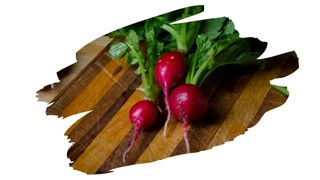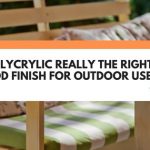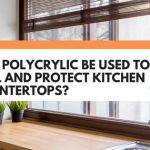Polycrylic is a fast-drying sealer that can protect interior wooden surfaces from water-damage. And the reason why this wood sealant is so popular is because it is incredibly easy to apply onto furniture, cabinets, and tabletops.
But, ease-of-use aside, is Polycrylic also food-safe too?
Related Post: 4 Reasons Why You Should NOT Use Polyurethane On A Butcher Block
Well, in this post, you’ll learn what really makes a wood finish food-safe — and whether or not Polycrylic fits the bill. You’ll also discover why food safe finishes aren’t ideal for surfaces that’ll have direct contact with food.
And keep reading to find out whether Polycrylic is the right wood finish for your kitchen tabletop.

This post may contain affiliate links to products that we receive a commission for (at no additional cost to you). Learn more here.
What Types Of Wood Finishes Are Food Safe?
As a general rule of thumb, if a wood finish dries and cures into a solid substance, then it’s food-safe. But, to go one step further, a truly food safe finish is one that only contains FDA-approved food-safe ingredients.
So, a dry Polycrylic coat — once it has finished curing — will seal any table top with a food-safe surface. What’s more, this water-resistant sealer is safe enough to have coating surfaces in kitchen and dining areas.
But, food-safe doesn’t mean a finish is safe enough to have direct contact with food.
What Do You Mean? What Is A Food Safe Sealant If It Can’t Have Direct Food Contact?
Here’s the thing; food-safe means that a finish is safe for indirect contact with food. So, this means that it can coat the walls of a kitchen or tabletops.
Yet, these food-safe finishes still contain chemicals and ingredients that are not suitable for human consumption. So they aren’t the right finish for surfaces such as chopping blocks or charcuterie boards.
Related Post: What Type Of Wood Finish Is Best Used On A Charcuterie Board?
That’s why you don’t want to run the risk of them getting into your food. And this is something that can happen if a food-safe finish has contact with food.
For example, some types of sealants can break down and dissolve if they come into contact with vinegar or alcohol. And even durable finishes, like Polycrylic and polyurethane, can become sliced by sharp cutlery.
Wait A Minute…Is Polycrylic The Same As Polyurethane?
Well, Polycrylic is the name given to a water-based acrylic urethane blended product made by Minwax. It is wildly popular due to its fantastic clear finishing coat and ease of use.
And due to its urethane ingredient, (which is found in polyurethane finishes in general), it can safeguard wood from water-damage and scratches.
So Is Polycrylic Really Waterproof?
It is a very reliable water-resistant sealer. In fact, it offers much better water-resistance than say a Tung oil or Boiled Linseed oil finish.
Nevertheless, it is not wholly waterproof. And if that Polycrylic finish gets drenched, water will soak past it into the wood underneath. This is why Polycrylic should only be used on interior wooden surfaces such as tables and chairs.
Related Post: Is Polycrylic Really The Right Wood Finish For Outdoor Use?
But, if you were to use Polycrylic on exterior wood, it wouldn’t offer much in the way of any real weatherproofing.
Is Polycrylic Toxic When Dry? Once this wood sealer has dried and cured into a solid durable coat, it is a food-safe surface. Which means it will no longer release fumes (also referred to as VOC’s Volatile Organic Compounds) into the air. Neither will it leech off any toxic chemicals.
What About Heat? Is Polycrylic Fairly Heat Resistant?
For a water-based finish, it certainly is. But it generally takes a lot to melt any urethane-based finish.
For example, polyurethane can resist heat up to temperature levels as high as 200°F (93°C).
Having said that, an oil-based polyurethane is thicker and penetrates deeper into wood. And this allows it to provide better heat resistance, from the inside out, than Polycrylic.
So Is Polycrylic Good For A Kitchen Table?
Absolutely…it will give your table a crystal clear finishing top coat.
Still, you’ll need to make sure you always use coasters and place mats (even if you use a table cloth). This is to protect the finish from water-ring damage or ‘blushing’.
What Do You Mean By A Wood Finish ‘Blushing’?
Blushing is when a wood finish starts to appear cloudy with a milky white ‘blush’. This usually happens when moisture gets into a finish or sealant before it’s had time to dry.
However, blushing can also occur if water condensation, (say from a hot cup of coffee), manages to make it’s way into a cured finish as well.
To Wrap Up, Here Are The 3 Key Takeaways From This Post…
- 1). Polycrylic is a water-based finish brand by Minwax. It is a fast-drying, easy to apply wood sealer.
- 2). This urethane-based wood sealer is water-resistant, but it is not wholly waterproof. It can become water-damaged if you place hot cups of coffee directly onto that Polycrylic coated tabletop.
- 3). Polycrylic works wonderfully on interior wooden surfaces, such as tables, chairs, and cabinets. However, it is not a suitable wood sealant for exterior wood.


![Help! Why Are There Air Bubbles In My Polycrylic Finish! [+ What You Can Do To Fix It] bubbles in polycrylic finish](https://www.thewoodworkplace.com/wp-content/uploads/2022/10/Banner-490-150x150.jpg)
